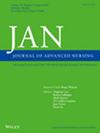重症监护中的安全护理实践:反思性主题分析
IF 3.8
3区 医学
Q1 NURSING
引用次数: 0
摘要
目的探讨重症监护护士在重症监护环境中日常护理实践中 "安全 "的含义。设计采用定性研究设计。方法该研究招募了来自瑞典三家医院的 18 名重症监护护士和护士长。访谈数据收集于 2017 年和 2024 年。结果 "保持安全心态"、"培养对患者安全的承诺"、"展现个人责任感和持续学习 "和 "管理复杂性,同时优先考虑安全标准 "等主题说明了重症护理环境中安全的意义。日常工作中的安全护理实践还包括对不断变化的环境或突发事件的适应能力和应变能力,确保彻底性,并在条件允许的情况下恢复常规工作,从而防止护理工作不完整。安全方面的核心能力包括技术技能和非技术技能,例如评估和使用技术的能力、保持警惕和彻底的能力、提前计划的能力、确定优先次序的能力、识别和跟进护理干预的能力,所有这些能力都需要在团队中工作并为患者分配足够的时间。进一步的研究应侧重于如何培养持续的安全心态。本研究丰富了我们对重症监护安全护理实践的理解。它为护理专业提供了更深层次的前瞻性安全工作理论,包括在技术先进的环境中降低风险的各种因素。本文章由计算机程序翻译,如有差异,请以英文原文为准。
Practising Safe Care in Critical Care: A Reflexive Thematic Analysis
AimTo explore the meaning of ‘safety’ as it applies to critical care nurses during daily care practice in the intensive care setting.DesignA qualitative study design was employed.MethodsThe study enlisted 18 critical care nurses and nurse leaders from three hospitals in Sweden. Interview data were collected in 2017 and in 2024. The data were examined using reflexive thematic content analysis.ResultsThe meaning of safety within critical care settings was illustrated by the themes ‘Sustaining a safety mindset’, ‘Fostering commitment to patient safety’, ‘Showing individual accountability and continuous learning’ and ‘Managing complexity while prioritising safety standards’. Safe care practice in daily practice also involved adaptability and resilience in response to changing circumstances or unexpected events, ensuring thoroughness and allowing for a return to regular routines when conditions permitted, thereby preventing incomplete care. Core competencies in safety encompassed both technical and non‐technical skills, such as the ability to assess and use technology, remain vigilant and thorough, plan ahead, prioritise and identify, and follow through on nursing interventions, all while working in a team and allocating sufficient time for patients.ConclusionSustaining a safe mindset over time is both challenging and essential. Further research should focus on how to foster a sustained safety mindset. A more proactive approach to learning may be achieved by reflecting on and discussing things that have worked well even in challenging circumstances.Implications for the Profession and/or Patient CareThis study enriches our understanding of practising safe care in intensive care. It furnishes the nursing profession with a deeper theoretical grasp of proactive safety efforts, encompassing various factors that can mitigate risks in a technologically advanced environment.
求助全文
通过发布文献求助,成功后即可免费获取论文全文。
去求助
来源期刊
CiteScore
6.40
自引率
7.90%
发文量
369
审稿时长
3 months
期刊介绍:
The Journal of Advanced Nursing (JAN) contributes to the advancement of evidence-based nursing, midwifery and healthcare by disseminating high quality research and scholarship of contemporary relevance and with potential to advance knowledge for practice, education, management or policy.
All JAN papers are required to have a sound scientific, evidential, theoretical or philosophical base and to be critical, questioning and scholarly in approach. As an international journal, JAN promotes diversity of research and scholarship in terms of culture, paradigm and healthcare context. For JAN’s worldwide readership, authors are expected to make clear the wider international relevance of their work and to demonstrate sensitivity to cultural considerations and differences.

 求助内容:
求助内容: 应助结果提醒方式:
应助结果提醒方式:


